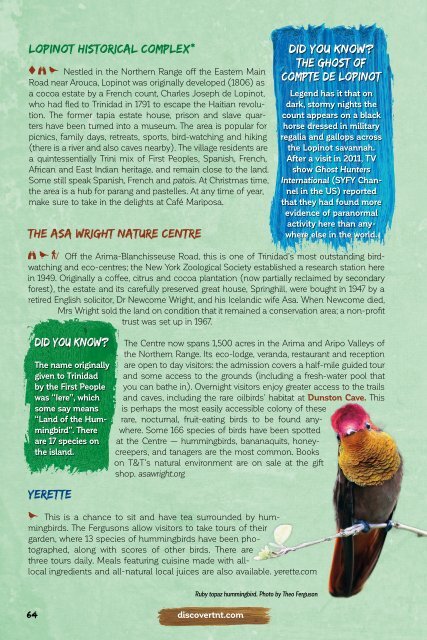Discover Trinidad & Tobago 2016 — 25th Anniversary Edition
With our 2016 edition (our 27th), we celebrate 25 years of producing Discover Trinidad & Tobago. Published every year since 1991, Discover Trinidad & Tobago is aimed both at international visitors planning a trip to the islands – whether for an eco adventure, business trip, or beach holiday – and at local Trinbagonians looking to know and explore more about their native islands. Our comprehensive coverage of Trinidad and Tobago — from arts and culture to eco adventures, accommodation to sports, planning flights and transportation and more — can help anyone plan anything from a day trip or weekend escape, to a full-on an adventure holiday or leisurely vacation. It might take a lifetime to truly experience all that the islands have to offer, but at least we can show you where to start. For more: http://www.discovertnt.com • http://www.facebook.com/discovertnt
With our 2016 edition (our 27th), we celebrate 25 years of producing Discover Trinidad & Tobago. Published every year since 1991, Discover Trinidad & Tobago is aimed both at international visitors planning a trip to the islands – whether for an eco adventure, business trip, or beach holiday – and at local Trinbagonians looking to know and explore more about their native islands. Our comprehensive coverage of Trinidad and Tobago — from arts and culture to eco adventures, accommodation to sports, planning flights and transportation and more — can help anyone plan anything from a day trip or weekend escape, to a full-on an adventure holiday or leisurely vacation. It might take a lifetime to truly experience all that the islands have to offer, but at least we can show you where to start. For more: http://www.discovertnt.com • http://www.facebook.com/discovertnt
You also want an ePaper? Increase the reach of your titles
YUMPU automatically turns print PDFs into web optimized ePapers that Google loves.
Lopinot Historical Complex*<br />
Nestled in the Northern Range off the Eastern Main<br />
Road near Arouca, Lopinot was originally developed (1806) as<br />
a cocoa estate by a French count, Charles Joseph de Lopinot,<br />
who had fled to <strong>Trinidad</strong> in 1791 to escape the Haitian revolution.<br />
The former tapia estate house, prison and slave quarters<br />
have been turned into a museum. The area is popular for<br />
picnics, family days, retreats, sports, bird-watching and hiking<br />
(there is a river and also caves nearby). The village residents are<br />
a quintessentially Trini mix of First Peoples, Spanish, French,<br />
African and East Indian heritage, and remain close to the land.<br />
Some still speak Spanish, French and patois. At Christmas time,<br />
the area is a hub for parang and pastelles. At any time of year,<br />
make sure to take in the delights at Café Mariposa.<br />
The Asa Wright Nature Centre<br />
Did you know?<br />
The ghost of<br />
Compte de Lopinot<br />
Legend has it that on<br />
dark, stormy nights the<br />
count appears on a black<br />
horse dressed in military<br />
regalia and gallops across<br />
the Lopinot savannah.<br />
After a visit in 2011, TV<br />
show Ghost Hunters<br />
International (SYFY Channel<br />
in the US) reported<br />
that they had found more<br />
evidence of paranormal<br />
activity here than anywhere<br />
else in the world.<br />
Off the Arima-Blanchisseuse Road, this is one of <strong>Trinidad</strong>’s most outstanding birdwatching<br />
and eco-centres; the New York Zoological Society established a research station here<br />
in 1949. Originally a coffee, citrus and cocoa plantation (now partially reclaimed by secondary<br />
forest), the estate and its carefully preserved great house, Springhill, were bought in 1947 by a<br />
retired English solicitor, Dr Newcome Wright, and his Icelandic wife Asa. When Newcome died,<br />
Mrs Wright sold the land on condition that it remained a conservation area; a non-profit<br />
trust was set up in 1967.<br />
Did you know?<br />
The name originally<br />
given to <strong>Trinidad</strong><br />
by the First People<br />
was “Iere”, which<br />
some say means<br />
“Land of the Hummingbird”.<br />
There<br />
are 17 species on<br />
the island.<br />
Yerette<br />
The Centre now spans 1,500 acres in the Arima and Aripo Valleys of<br />
the Northern Range. Its eco-lodge, veranda, restaurant and reception<br />
are open to day visitors: the admission covers a half-mile guided tour<br />
and some access to the grounds (including a fresh-water pool that<br />
you can bathe in). Overnight visitors enjoy greater access to the trails<br />
and caves, including the rare oilbirds’ habitat at Dunston Cave. This<br />
is perhaps the most easily accessible colony of these<br />
rare, nocturnal, fruit-eating birds to be found anywhere.<br />
Some 166 species of birds have been spotted<br />
at the Centre <strong>—</strong> hummingbirds, bananaquits, honeycreepers,<br />
and tanagers are the most common. Books<br />
on T&T’s natural environment are on sale at the gift<br />
shop. asawright.org<br />
This is a chance to sit and have tea surrounded by hummingbirds.<br />
The Fergusons allow visitors to take tours of their<br />
garden, where 13 species of hummingbirds have been photographed,<br />
along with scores of other birds. There are<br />
three tours daily. Meals featuring cuisine made with alllocal<br />
ingredients and all-natural local juices are also available. yerette.com<br />
64 discovertnt.com<br />
Ruby topaz hummingbird. Photo by Theo Ferguson


















